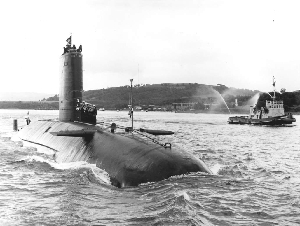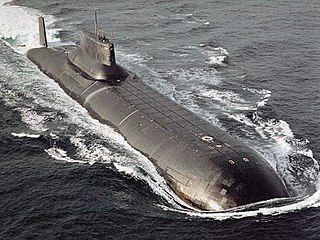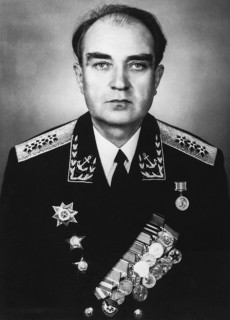
K-219 was a Project 667A Navaga-class ballistic missile submarine of the Soviet Navy. It carried 16 R-27U liquid-fuel missiles powered by UDMH with nitrogen tetroxide (NTO). K-219 was involved in what has become one of the most controversial submarine incidents during the Cold War on Friday 3 October 1986. The 15-year-old vessel, which was on an otherwise routine Cold War nuclear deterrence patrol in the North Atlantic 1,090 kilometres (680 mi) northeast of Bermuda, suffered an explosion and fire in a missile tube. While underway a submerged seal in a missile hatch cover failed, allowing high-pressure seawater to enter the missile tube and owing to the pressure differential rupture the missile fuel tanks, allowing the missile's liquid fuel to mix and ultimately combust. Though there was no official announcement, the Soviet Union claimed the leak was caused by a collision with the submarine USS Augusta. Although Augusta was operating within the area, both the United States Navy and the commander of K-219, Captain Second Rank Igor Britanov, deny that a collision took place.

The Kirov class, Soviet designation Project 1144 Orlan, is a class of nuclear-powered guided-missile battlecruisers of the Soviet Navy and Russian Navy, the largest and heaviest surface combatant warships in operation in the world. Among modern warships, they are second in size only to large aircraft carriers, and of similar size to a World War I-era battleship. The ships are often referred to as battlecruisers by Western defence commentators due to their size and general appearance. The Soviet classification of the ship-type is "heavy nuclear-powered guided-missile cruiser".

HMS Conqueror was a British Churchill-class nuclear-powered fleet submarine which served in the Royal Navy from 1971 to 1990. She was the third submarine of her class, following the earlier Churchill and Courageous, that were all designed to face the Soviet threat at sea. She was built by Cammell Laird at Birkenhead.

The Russian navy is the naval arm of the Russian Armed Forces. It has existed in various forms since 1696; its present iteration was formed in January 1992 when it succeeded the Navy of the Commonwealth of Independent States.

USS Triton (SSRN/SSN-586), the only member of her class, was a nuclear powered radar picket submarine in the United States Navy. She had the distinction of being the only Western submarine powered by two nuclear reactors. Triton was the second submarine and the fourth vessel of the United States Navy to be named for the Greek god Triton, At the time of her commissioning in 1959, Triton was the largest, most powerful, and most expensive submarine ever built at $109 million excluding the cost of nuclear fuel and reactors.

Seaview, a fictional nuclear submarine, was the setting for the 1961 motion picture Voyage to the Bottom of the Sea, starring Walter Pidgeon, and later for the 1964–1968 ABC television series of the same title. In the film, Seaview fires a ballistic missile with a nuclear warhead to extinguish the Van Allen belt that was set on fire by a space cataclysm.

The Typhoon class, Soviet designation Project 941 Akula, was a class of nuclear-powered ballistic missile submarines designed and built by the Soviet Union for the Soviet Navy. With a submerged displacement of 48,000 tonnes, the Typhoons were the largest submarines ever built, able to accommodate comfortable living facilities for the crew of 160 when submerged for several months. The source of the NATO reporting name remains unclear, although it is often claimed to be related to the use of the word "typhoon" ("тайфун") by General Secretary Leonid Brezhnev of the Communist Party in a 1974 speech while describing a new type of nuclear ballistic missile submarine, as a reaction to the United States Navy's new Ohio-class submarine.

The Soviet Navy was the naval warfare uniform service branch of the Soviet Armed Forces. Often referred to as the Red Fleet, the Soviet Navy made up a large part of the Soviet Union's strategic planning in the event of a conflict with the opposing superpower, the United States, during the Cold War (1945–1991). The Soviet Navy played a large role during the Cold War, either confronting the North Atlantic Treaty Organization in western Europe or power projection to maintain its sphere of influence in eastern Europe.
The Strategic Forces Command (SFC), sometimes called Strategic Nuclear Command, forms part of India's Nuclear Command Authority (NCA). It is responsible for the management and administration of the country's tactical and strategic nuclear weapons stockpile. It was created on 4 January 2003 by the Vajpayee Government. Air Marshal Teja Mohan Asthana became its first commander-in-chief.

Crimson Tide is a 1995 American submarine action thriller film directed by Tony Scott and produced by Don Simpson and Jerry Bruckheimer. It takes place during a period of political turmoil in Russia, in which ultranationalists threaten to launch nuclear missiles at the United States and Japan.

The Israeli Navy is the naval warfare service arm of the Israel Defense Forces, operating primarily in the Mediterranean Sea theater as well as the Gulf of Eilat and the Red Sea theater. The current commander in chief of the Israeli Navy is Aluf David Saar Salama. The Israeli Navy is believed to be responsible for maintaining Israel's offshore nuclear second strike capability.

The Hunt for Red October is a 1990 American submarine spy thriller film directed by John McTiernan, produced by Mace Neufeld, and starring Sean Connery, Alec Baldwin, Scott Glenn, James Earl Jones, and Sam Neill. The film is an adaptation of Tom Clancy's 1984 bestselling novel of the same name. It is the first installment of the film series with the protagonist Jack Ryan.

The Atomic Submarine is a 1959 independently made, American black-and-white science-fiction film directed by Spencer Gordon Bennet and starring Arthur Franz, Dick Foran, Brett Halsey, Joi Lansing and Jean Moorhead, with John Hilliard as the voice of the alien. The film was produced by Alex Gordon and distributed by Allied Artists Pictures Corporation.

Solar Attack is a 2006 television film by CineTel Films and Lions Gate Entertainment, starring Mark Dacascos, Joanne Kelly and Louis Gossett Jr.

K-129 was a Project 629A diesel-electric-powered ballistic-missile submarine that served in the Pacific Fleet of the Soviet Navy–one of six Project 629 strategic ballistic-missile submarines assigned to the 15th Submarine Squadron based at Rybachiy Naval Base near Petropavlovsk, commanded by Rear Admiral Rudolf Golosov.

Operation Sandblast was the code name for the first submerged circumnavigation of the world, executed by the United States Navy nuclear-powered radar picket submarine USS Triton (SSRN-586) in 1960 under the command of Captain Edward L. Beach Jr.

The 1966 Soviet submarine global circumnavigation, was announced to be the second submerged around-the-world voyage executed by the detachment of the nuclear powered submarines that served in the Soviet Navy.

Incident at Map Grid 36-80 is a 1982 Soviet military action movie by Mikhail Tumanishvili. The total number of Soviet viewers was estimated at 33,100,000 people.

Emil Nikolayevich Spiridonov was an officer of the Soviet Navy. He rose to the rank of admiral and was commander of the Pacific Fleet, before his death in the 1981 Pushkin Tu-104 crash, which also killed many of the Fleet's senior officers.

Vladimir Lvovich Kasatonov is an officer of the Russian Navy. He currently holds the rank of admiral, and since 2019 has served as deputy commander in chief of the navy.


















